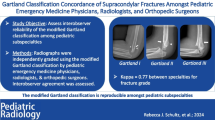Abstract
Purpose
To demonstrate the effect of teaching a simplified treatment-based classification of proximal femoral fractures on the accuracy, confidence, and inter-reader agreement of radiology residents. The authors hypothesize that these measures will improve after viewing an educational presentation.
Materials and methods
Three radiology residents independently classified 100 operative proximal femoral fractures, both before and after viewing a 45-min educational video describing the simplified classification scheme, with a washout period of at least 12 weeks between sessions. Based on the gold standard established by consensus of two radiologists and an orthopedic trauma surgeon utilizing intraoperative fluoroscopic imaging, operative reports, and pre-procedural imaging, accuracy of classification was calculated for each reader before and after viewing the educational video. Reader confidence was recorded on a 0–10 scale, and inter-reader agreement was calculated with Fleiss’s kappa. McNemar’s test was used to compare accuracy, a paired t test was used to compare confidence, and the Z-test was used to compare kappa values after bootstrapping to determine the standard error of the mean.
Results
The study cohort included 60/100 females, with a mean age of 76.6 years. The pooled classification accuracy was initially 65%, which improved to 80% in the second reading session after viewing the educational video (p < 0.0001). Confidence improved from 6.9 initially to 8.6 (p < 0.0001). Inter-reader agreement improved from a kappa of 0.45 (moderate agreement) to 0.74 (substantial agreement) (p < 0.0001).
Conclusions
A simplified treatment-based classification of proximal femoral fractures is easily taught to radiology residents and resulted in increased accuracy, increased inter-reader agreement, and increased reader confidence.







Similar content being viewed by others
References
Cummings SR, Rubin SM, Black D (1990) The future of hip fractures in the United States. Numbers, costs, and potential effects of postmenopausal estrogen. Clin Orthop Relat Res NA(252):163–166
Johnell O, Kanis JA (2006) An estimate of the worldwide prevalence and disability associated with osteoporotic fractures. Osteoporos Int 17(12):1726–1733
Kanis JA, Odén A, McCloskey EV, Johansson H, Wahl DA, Cooper C (2012) A systematic review of hip fracture incidence and probability of fracture worldwide. Osteoporos Int 23(9):2239–2256
Sheehan SE, Shyu JY, Weaver MJ, Sodickson AD, Khurana B (2015) Proximal femoral fractures: what the orthopedic surgeon wants to know. Radiographics 35(5):1563–1584
Andersen E, Jørgensen LG, Hededam LT (1990) Evans’ classification of trochanteric fractures: an assessment of the interobserver and intraobserver reliability. Injury 21(6):377–378
Blundell CM, Parker MJ, Pryor GA, Hopkinson-Woolley J, Bhonsle SS (1998) Assessment of the AO classification of intracapsular fractures of the proximal femur. J Bone Joint Surg Br. 80(4):679–683
Frandsen PA, Andersen E, Madsen F, Skjødt T (1988) Garden’s classification of femoral neck fractures. An assessment of inter-observer variation. J Bone Joint Surg Br 70(4):588–590
Guyver PM, McCarthy MJH, Jain NPM, Poulter RJ, McAllen CJP, Keenan J (2014) Is there any purpose in classifying subtrochanteric fractures? The reproducibility of four classification systems. Eur J Orthop Surg Traumatol 24(4):513–518
Thomsen NOB, Jensen CM, Skovgaard N, Pedersen MS, Pallesen P, Soe-Nielsen NH, Rosenklint A (1996) Observer variation in the radiographic classification of fractures of the neck of the femur using Garden’s system. Int Orthop 20(5):326–329
Khurana B, Mandell JC, Rocha TC, Duran-Mendicuti MA, Jimale H, Rosner B, Harris MB, Sodickson AD, Weaver MJ (2018 Aug) Internal rotation traction radiograph improves proximal femoral fracture classification accuracy and agreement. Am J Roentgenol 211(2):409–415
Mandell JC, Weaver MJ, Harris MB, Khurana B (2018) Hip fractures: a practical approach to diagnosis and treatment. Curr Radiol Rep 6(7)
Mandell JC, Marshall RA, Banffy MB, Khurana B, Weaver MJ (2018) Arthroscopy after traumatic hip dislocation: a systematic review of intra-articular findings, correlation with magnetic resonance imaging and computed tomography, treatments, and outcomes. Arthroscopy 34(3):917–927
Mandell JC, Marshall RA, Weaver MJ, Harris MB, Sodickson AD, Khurana B. Traumatic hip dislocation: what the orthopedic surgeon wants to know. Radiographics 37(7):2181–2201
Heikal S, Riou P, Jones L (2014) The use of computed tomography in identifying radiologically occult hip fractures in the elderly. Ann R Coll Surg Engl 96(3):234–237
Pandey R, McNally E, Ali A, Bulstrode C (1998 Jan) The role of MRI in the diagnosis of occult hip fractures. Injury 29(1):61–63
Ly TV, Swiontkowski MF (2014) Intracapsular hip fractures. In: Browner BD, Jupiter JB, Krettek C, Anderson PA, editors. Skeletal trauma: basic science, management, and reconstruction. Fifth Edit. Philadelphia, PA: Saunders p. 1607–1681.e12
Hostetter J, Khanna N, Mandell JC (2018 Jun) Integration of a zero-footprint cloud-based picture archiving and communication system with customizable forms for radiology research and education. Acad Radiol 25(6):811–818
Landis JR, Koch GG (1977) The measurement of observer agreement for categorical data. Biometrics 33(1):159–174
Watson ST, Schaller TM, Tanner SL, Adams JD, Jeray KJ (2016 Jul 6) Outcomes of low-energy basicervical proximal femoral fractures treated with cephalomedullary fixation. J Bone Joint Surg Am 98(13):1097–1102
Author information
Authors and Affiliations
Corresponding author
Ethics declarations
This retrospective study was approved by our institutional review board with waiver of informed consent and was in compliance with Health Insurance Portability and Accountability Act regulations.
Conflict of interest
The authors declare that they have no conflict of interest.
Rights and permissions
About this article
Cite this article
Mandell, J.C., Wrobel, W.C., Laur, O. et al. A simplified classification of proximal femoral fractures improves accuracy, confidence, and inter-reader agreement of hip fracture classification by radiology residents. Emerg Radiol 26, 179–187 (2019). https://doi.org/10.1007/s10140-018-1660-5
Received:
Accepted:
Published:
Issue Date:
DOI: https://doi.org/10.1007/s10140-018-1660-5




